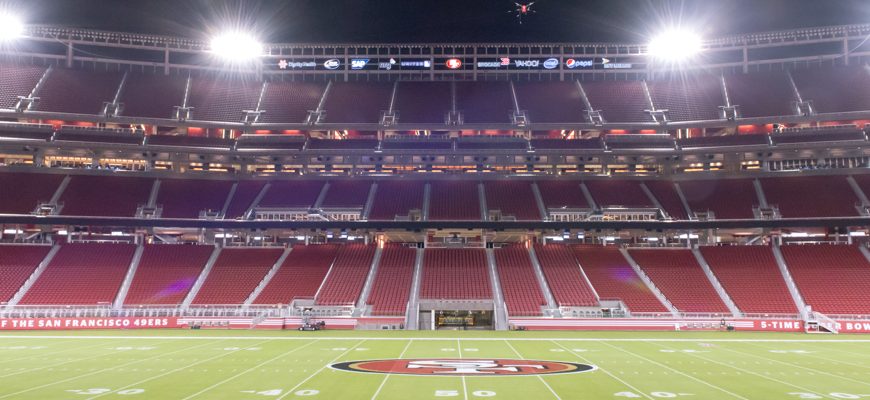Since its 2014 opening, Levi’s Stadium has generated $350 million in direct and indirect economic activity in the City of Santa Clara. That’s according to a study commissioned by the San Francisco 49ers and published Oct. 2 by Emeryville-based Sports Economics.
“This is why the current council was so eager to relax the [10 p.m. weekday] curfew — because of the economic impact,” said Council Member Suds Jain.
The study found the stadium delivered $35.6 million in incremental revenue to Santa Clara’s general fund since opening — including $13.8 million in performance and ground rent — and $311 million in ticket fees and stadium rents to the Santa Clara Stadium Authority (SCSA).
Researchers say overall, Levi’s Stadium has brought $2.1 billion in economic impact to Santa Clara County — $1.5 billion through direct spending and another $555 million of indirect impact. Other findings show that in 10 years of operation, the stadium brought 8.7 million people to 155 major events and nearly 1,000 corporate and private events. Alongside that, the stadium reportedly created 11,840 full-time jobs and boosted local earnings by $550 million.
“We have worked hard to ensure that Santa Clarans are benefiting from the Stadium,” said City Council Member Karen Hardy, “And this report is an encouraging sign that for the past decade we’ve been able to accomplish that.”

How the Numbers are Calculated
Direct economic impact looks at how the money is spent by people attending stadium events, rather than outside of the local economy. This spending boosts local employment and puts additional earnings into the local economy.
Indirect economic impact results from “re-spending” those dollars in the local economy. Total economic impact is the sum of both numbers.
Fiscal impacts are public agency taxes, fees and profits collected as a direct result of visitors traveling to the area to stadium events.
Visitor spending on tickets, concessions and merchandise inside the venue doesn’t count toward economic impact because it’s assumed that this spending covers the costs of the event, and doesn’t necessarily benefit local businesses. Spending by residents isn’t included, either, because that money would likely be spent in the local economy for other things.
The study results are based on surveys and information gathered during events, as well as already-existing data sources such as sales tax collections. Indirect spending was calculated using a regional economic impact model.
Analysis of 19 Events Shows Healthy Fiscal Returns for SCSA and City
Sports Economics analyzed 19 separate stadium events from 2018 through July 2023: 7 NFL games, 3 college football games, 3 soccer matches and 6 concerts. Per event fiscal returns to the SCSA and the City exclude the various rents paid by the 49ers to the Authority, and the ground and performance rent paid to the City. (These are calculated on an annual basis and are included in the summary numbers.)
Each event, on average, earned the SCSA $446,000 from ticket fees – ranging from $98,000 to $1.7 million. The City of Santa Clara collected an average of $178,000 from parking fees and hotel and sales taxes — ranging from $44,000 to $1.14 million.
NFL games delivered the highest fee and tax returns; averaging, per game, $1.15 million to the SCSA and $301,000 to the City’s bottom line. Concerts were next, delivering $246,000 to the SCSA and $170,000 to the City. Soccer games delivered an average $226,000 to the stadium authority, but only $55,000 to the City’s bottom line.
Even events that don’t deliver profits to the City, nonetheless benefit Santa Clara. College football, which had been criticized as unprofitable, nonetheless delivered $159,000 on average per event to the SCSA and $187,000 to the City.
For example, despite being unprofitable for the 49ers Stadium Management Company (the City was covered for all its costs) the College Football Playoff National Championship in 2018 delivered $262,000 to the SCSA and $455,000 to Santa Clara’s general fund. People coming to this event spent $295 per person, per day in the county — far and away the highest daily spending for any of the 19 events.
“Levi’s Stadium was built to be an economic asset for Santa Clara and this report shows that in less than 10 years we are exceeding expectations and have had a profoundly positive effect on the City,” said San Francisco 49ers President Al Guido. “We’ve worked hard to deliver to the community and it’s gratifying to see that our partnership with the City is translating to billions of dollars for our neighbors.”
Jain agrees.
“I’m not surprised by these numbers,” he said. “But as somebody who questioned the value of building the stadium, I only wish the city had negotiated the contracts so that more money flows to the City.”
Read the Sports Economics Report: 2023 Levi’s Stadium economic impact analysis







All this money came into Santa Clara in spite of the hatred of the 49ers and the stadium by the mayor and her cabal.
Great! Now what are they going to do about parking?